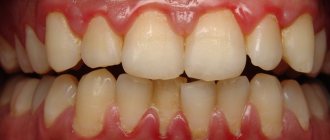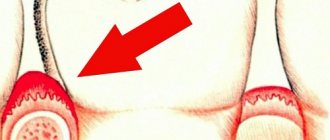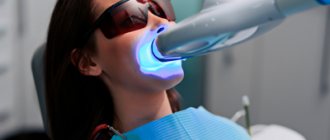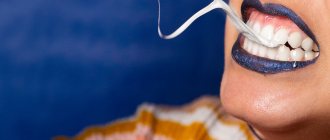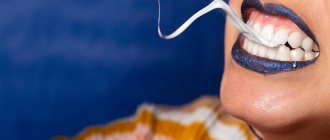Types of massage Finger massage Contraindications
Gum massage will be useful for everyone. It improves blood circulation, lymph flow, tissue metabolism, and saturates tissues with oxygen. Regular procedures increase the thickness of the epithelium, which protects the gums from the penetration of bacteria. However, there are diseases for which gum massage is an essential component of complex therapy. These are periodontal diseases: the tissues and ligaments that hold the tooth in the gum. These are gingivitis, periodontitis, periodontal disease. All of them are characterized by bleeding gums.
Gums bleed due to overgrowth of bacteria in the mouth. Most often this indicates poor hygiene, but there are cases when bleeding is caused by improper prosthetics, smoking, or internal diseases.
Gum massage is carried out in medical institutions as a physiotherapeutic procedure and at home as maintenance therapy.
Indications and contraindications
Gum massage can be performed for both preventive and therapeutic purposes. In each case, you should consult a dentist who will recommend a technique and means.
- For periodontitis, the gums are massaged only with your fingers, using smooth, slow movements. For comfort, fingers are lubricated with olive oil or toothpaste.
- For periodontal disease, special medical oils and gels are used. Massage with fingers or irrigator.
Contraindications to self-massage are:
– short period from the moment of tooth extraction, partial or complete adentia (absence of teeth);
– braces, dentures;
– inflammation in the oral cavity, purulent or bloody discharge;
– large carious lesions;
– presence of teeth/roots requiring removal.
Secrets that will make self-massage more effective
To achieve maximum results, it is recommended to first conduct a complete examination of the oral cavity, remove plaque and tartar. This can be done in a clinic or using gum massage devices.
After the procedure, you need to rinse your mouth using herbal decoctions, which enhance the massage effect, relieve swelling, and disinfect the oral cavity. In addition, it is recommended to combine several massage techniques, do hydromassage with mineral water, and use toothpastes with a therapeutic effect.
Author of the article
Techniques
Massage the gums with your fingers (in the evening) or with a soft toothbrush (in the morning).
- Self-massage with fingers is performed with washed hands after hygienic brushing of teeth in the following sequence:
- Using light stroking movements, the pads of the index fingers of both hands move along the gum from the front teeth to the distant wisdom teeth. Repeat on each jaw 5–7 times.
- Rub the gums in a circular motion, moving along the gum from one wisdom tooth to another, gradually increasing the pressure.
- Wrap your fingers around the gum on both sides and squeeze near each tooth for 6–7 seconds, moving from the center to the far teeth.
- Complete the massage with soft strokes.
- There are several techniques for massaging your gums using a soft toothbrush:
- According to Charters. The brush is placed at the base of the teeth, massaging the enamel surface with vibrational movements up and down, capturing the edge of the gum. At the beginning of the procedure, the affected tissues are not affected.
- According to Shtilman. The brush is positioned at an angle of 45° with the bristles down, and carefully moved along the interdental spaces. During massage, not only cleaning occurs, but also increased blood flow.
- According to Bell. The brush is moved, grabbing the edge of the gum, in one direction - from the base of the teeth to the cutting edges. With slow movements, possible suppuration from the mucous membranes comes out.
- According to Fones. With the jaws closed, place the brush on the teeth at an angle of 90°. They make circular spiral movements along both rows of teeth, capturing the edge of the gums. When opening the mouth, repeat on the distal (back) side of the teeth.
- According to Hirschfeld. Pass the bristles from the neck of the teeth to the edge, capturing the edge of the gum. The direction of movement on the teeth of the lower jaw is from bottom to top, on the teeth of the upper jaw – from top to bottom.
Features of massage for periodontal disease and periodontitis
Massage for periodontal disease and periodontitis is carried out after sanitation of the oral cavity, taking into account the following features:
– gentle types of self-massage are performed with a toothbrush (according to Charters, Shtilman);
– finger massaging begins in healthy areas, gradually moving to the sick;
– after the procedure, the mouth is rinsed with a decoction of recommended herbs or a solution of tea tree oil (7-10 drops per glass of water).
To enhance the effect of the massage, applications are made - a medicinal product is applied to a cotton swab and held on the gum for 15 minutes. You can use fir oil, honey with added salt, or a mixture of 1 teaspoon of raw grated honey with the addition of 10 drops of vegetable oil.
Treatment with applications is carried out for 14 days, followed by a break.
Types of massage
Before starting a massage course, you need to sanitize your mouth. Otherwise there will be no result. The dentist treats caries, removes tartar and plaque, and only after that prescribes massage procedures.
Massage can be:
- Vacuum
It is carried out in the clinic with a special device. Vacuum massage of the gums for periodontitis and other inflammations of the mucous membrane helps stimulate the immune system, improve trophism, and saturate the blood with oxygen.
A glass tube with an extension at the end is applied to the gums for 1-4 minutes
. Due to the pressure difference, rarefied air (vacuum) is created in the tube and it sticks to the mucous membrane. Recently, vacuum therapy has been combined with laser beam irradiation. The beam is low-frequency, red spectrum. Has anti-inflammatory and analgesic effects.
- Hydrolaser
A stream of water, most often mineral, in combination with infrared laser radiation is directed onto the mucous membrane. A stream of water from the massager washes away food debris and decay products not only from interdental crevices, but also from periodontal pockets. Hydrolaser massage of gums during periodontal disease relieves pain and bleeding. Recommended for receding gums, to improve their nutrition and blood supply.
- Gum massage with an irrigator
It is carried out at home. A stream of water removes food debris from between teeth. Removes plaque from teeth. It helps well with periodontal diseases, after implantation, prosthetics with fixed dentures, and installation of braces.
A dentist or hygienist will show you how to massage with an irrigator.
- Using a brush
There are brushes for massaging the gums, but most often at home they use regular soft toothbrushes. It is recommended to massage your gums daily for at least 3 minutes in one of the following ways:
- Holding the brush at an angle of 45 degrees,
make circular movements, grabbing the gum and the place where it connects to the tooth. - With the teeth closed, circular movements are made while holding the brush perpendicularly.
The most accessible, simple and cheap method is self-massage with your fingers.
Vacuum gum massager
For complex treatment, dentists offer gum massage using a special massager with vacuum tubes .
This technique is based on the effect of negative pressure on periodontal tissue, which increases blood supply. From the deep layers, blood and lymph move closer to the mucous membrane and bone, then under the influence of the procedure, capillaries rupture and a hematoma is formed. During its gradual healing, substances are released that actively stimulate local immunity.
The formation of a hematoma is a rather painful process, so it is worth using local anesthesia .
This method of massaging the gums is prescribed for gingivitis and periodontal disease , and it is also often used before surgical interventions to relax the tissues of the oral cavity. In addition, it is especially useful after operations, as it reduces the possibility of lymph stagnation and significantly reduces the secretion of ichor.
Important! The vacuum method does not cancel a trip to a specialist for a preventive examination, but it keeps the mucous membrane in good shape and protects surfaces from pathogenic bacteria.
Vacuum therapy has several advantages :
- stimulation of periodontal tissues;
- reducing the number of pathogenic bacteria;
- the appearance of new blood vessels;
- strengthening the mucosa;
- getting rid of excess fluid;
- flow of nutrients to damaged areas.
Contraindications to the procedure
The following factors are contraindications:
- advanced form of caries;
- suppuration in the gum pockets and fluid secretion;
- during the healing of sockets after tooth extraction;
- tartar, acute form of infectious and inflammatory diseases;
- lack of teeth;
- ulcers, oral infections (viral, bacterial, microbial, stomatitis);
- problems with blood clotting;
- malignant tumors;
- febrile state, temperature, infectious diseases.
Wearing braces and dentures requires careful massaging techniques after consultation with a doctor.
If there are restrictions, it is necessary to eliminate them: undergo drug treatment, put fillings, remove tartar, have a specialist clean the gum canals from pus.
After eliminating contraindications, agree on the possibility of performing a gum massage with the dentist, discuss the recommended techniques, and, if necessary, additional medications and solutions to increase the effectiveness of the procedure.
Impact on active points of the body
Important: if you combine massage with rinsing to strengthen the gums, the effect of tissue restoration will occur much faster; it is customary to complete the massage with a therapeutic rinse, in addition, this will help wash away the remnants of the substance with which the procedure was performed.
Another pleasant and useful addition to gum massage is massage of biologically active points that are located on the gums. On the upper jaw they are located above the roots of the teeth, along the very top of the gums. On the lower jaw, under the roots, along the lower edge of the gums.
There are several areas that can help solve problems with the body that are not related to dentistry:
- the first and second teeth on either side of the center of the jaw are surrounded by points through which the kidneys, ears and bladder can be affected;
- through the area around the third tooth you can influence the functioning of the liver and gall bladder;
- by massaging the gums around the fourth and fifth teeth on either side of the center of the jaw, the patient has a positive effect on the functioning of the lungs and large intestine;
- the sixth and seventh teeth are surrounded by areas responsible for the well-being of the stomach, spleen and pancreas;
- the effect on the gums of the eighth teeth has a positive effect on the small intestine and the heart.
Important: the ideal option is to apply all impact methods in one massage session, starting and ending with the first technique.
Thus, a patient who has developed a good habit of massaging his gums every time he brushes his teeth has a positive effect not only on the condition and health of his gums and teeth. It also helps your body work better and successfully cope with ailments. Massage after tooth extraction will help during the rehabilitation period after the procedure, the main thing is that it is performed as intended and with the consent of the dentist.
Category: Tooth extraction Published by Mister stomatolog
Preparing to massage your child’s gums
If you decide to massage simply with your finger, then you need to wash it very thoroughly, disinfect it, trim your nails well and get rid of any dirt in this area. However, it is best to use special napkins or finger pads for massage, which can not only massage, but also clean the baby’s teeth and mouth. The Asepta Baby finger napkin helps get rid of any pathogens in the child’s mouth and relieves pain during teething. If you decide to use such a napkin, then preparing for the massage becomes much easier: you need to wash your hands and put a fingertip on your finger. The soft structure will help to gently act on the eruption site, while cleaning the gums from plaque.
For periodontal disease and periodontitis (exposure of the tooth root)
With periodontal disease and periodontitis, the mucous membrane around the teeth becomes hypersensitive to temperature changes .
Bacteria begin to multiply in the interdental areas, causing inflammation and purulent discharge. The gums soften, losing their usual elasticity and begin to bleed heavily. The patient feels these symptoms every time he brushes his teeth and while eating.
When a tooth root is exposed , special medications are used for treatment, but massage , which is prescribed as an additional treatment procedure, helps to enhance their effect. The teeth are first cleaned of plaque, and the procedure itself is carried out using clean fingers. Massage significantly improves metabolic processes, gums become stronger and healthier .
The procedure is simple: you need to apply a few drops of essential oil to a cotton pad and apply to the gums for 7-10 minutes . The procedure must be performed daily for two weeks, then you should take a break .
For your information! The use of natural essential oils will greatly enhance the effect and simplify the procedure. The most beneficial oils will be mint, tea tree, lemon and eucalyptus.
Self-massage techniques with fingers
Important: gum massage should not be carried out with a long manicure, this can damage fragile gum tissue.
You can massage your gums in different ways, focusing on healthy and problematic areas of the jaw. Massage during tooth extraction is best done using the finger method.
Here are some possible options:
- Stroking is the main tool for preventive action on the gums. They are encouraged to start and end the procedure. If, after extracting a tooth, there is a clear swollen area on the gum, then manipulations begin from a place where there is no swelling, gradually moving towards the problem area.
- Trituration. This technique involves a strong impact on the gums, which means it can only be performed after the doctor’s instructions. Rubbing is performed using spiral movements from the middle of the gum to its edges. This method has two variations: direct massage and indirect massage. Direct is performed directly on the gums, not straight - through the cheek.
- Squeezing is carried out with vertical rotational movements.
- Squeezing is a method of simultaneous compression of the gums with the index finger and thumb. In this case, one compression is very short-lived. Strength of impact: medium, no pain or tingling should be felt.
The video in this article and photos will demonstrate the difference between different massage techniques.
Important: if, at the end of the massage, something pricks in the gum after removal, you must definitely visit the dentist and talk about the symptom; you may need to cancel the procedure.
How can you tell if your baby is teething?
As a rule, a baby's first teeth appear at 4-7 months. Each baby has its own set of teething symptoms. Some suffer from high fever, some from intestinal upset.
Very often, parents confuse the appearance of teeth with an acute respiratory disease; teething symptoms can be so serious.
Most often, teething is accompanied by symptoms such as:
- Moist cough.
When the incisors appear, the baby suffers from profuse salivation and a slight cough. The fact is that when a child lies down, saliva collects in the throat. To get rid of fluid, the baby coughs. When sitting, the cough does not appear and goes away on its own after 2-3 days. If it lasts more than 2 days and is accompanied by shortness of breath and wheezing, parents should contact their pediatrician as soon as possible. - Runny nose.
During teething, the amount of mucus also increases in the nose. Transparent and liquid mucus also disappears on its own after 3-4 days. If copious cloudy white or greenish mucus flows from the nose, it is better to show the baby to a doctor. - Temperature increase.
Very often, when teething, the child’s body temperature rises to 37-38 degrees. The gum area produces bioactive substances that accompany the appearance of teeth. Normally, the temperature subsides after 2 days. However, if the baby still has a fever after two days, parents should consult a doctor. - Gastrointestinal disorder.
The baby constantly swallows saliva, thereby accelerating intestinal motility. When teething, many babies experience diarrhea with watery stools. The urge to go to the toilet occurs in the baby no more than 2-3 times a day. If intestinal upset lasts a long time, intense bowel movements can cause dehydration. If the disorder lasts for a long time, you should definitely visit a doctor. In rare cases, when teething, instead of diarrhea, the baby begins to experience constipation. It is important for parents not to allow it to last more than 3 days.
Almost always, teething in babies is accompanied by particularly swelling and soreness of the gums and, of course, frequent crying and fatigue.
How does the postoperative period proceed and recommendations?
After tooth extraction, the patient must know what happens to the gums after tooth extraction.
Table No. 1. Stages of restoration of soft and hard gum tissue:
| The progress of restoration of the gum mucosa | The progress of gum bone tissue restoration |
| bleeding after tooth extraction should end within half an hour to three hours; · after the bleeding has stopped, you can see a clot in the hole, this is what remains in the gum after tooth extraction, it is very important for normal tissue healing; sometimes the doctor puts medicine into the gums after tooth extraction; this may be necessary if the extraction was difficult; after a few days the wound is covered with a thin light film; a week after removal, the hole becomes white; from two to three weeks (depending on the complexity of removal), the final formation of the epithelial tissue occurs, the mucous membrane is completely restored. | the first two weeks, only soft tissue is restored; in the interval from the second to the fifth week, new bone tissue grows on the sides of the socket, and the inner surface of the socket gradually begins to fill with tissue; by the sixth week the entire socket consists entirely of young bone tissue, then within a week it becomes hard, mature tissue; between the third and fourth months, the new bone tissue becomes one with the jaw bones; six months after tooth extraction, bone fusion is completed and the gum bone is finally formed. |
The postoperative period can take place in different ways, it all depends on the size of the tooth, its location, and the correctness of the procedure. At the end of the procedure, you should ask the doctor how to calm the gums after tooth extraction.
Usually recommended and prescribed:
- painkillers, local or general;
- antiseptic rinses, the price of drugs for this is not high;
- gentle diet and drinking;
- hygiene procedures;
- gum massage;
- The doctor should also tell you what to apply to the gums after tooth extraction; as a rule, cold is used.
Indications: in what cases is it used?
Many degenerative processes occurring in the oral cavity are indications for gum massage , the main ones being:
- periodontal disease - massage is performed to normalize blood circulation in the oral cavity;
- periodontitis - according to dentists, gum massage is one of the best means for preventing and treating the disease;
- Dental prosthetics - by massaging the gums before installing the prosthesis, you can significantly simplify the procedure. As a result, healing will occur much faster;
- incorrect bite - in this case, gum massage is prescribed by a doctor in order to straighten the teeth;
- gingivitis - massage will relieve swelling and reduce bleeding of the gums;
- gum recession – massage will help activate tissue growth.
